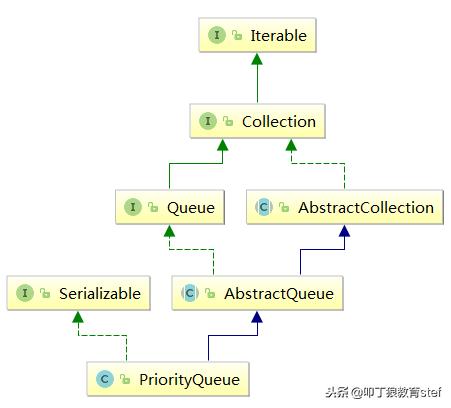概念
Priority queue 一个基于优先级的无界优先级队列。优先级队列的元素按照其自然顺序进行排序,或者根据构造队列时提供的 Comparator 进行排序,具体取决于所使用的构造方法。该队列不允许使用 null 元素也不允许插入不可比较的对象(没有实现Comparable接口的对象)。
PriorityQueue 队列的头指排序规则最小那哥元素。如果多个元素都是最小值则随机选一个。
PriorityQueue 是一个无界队列,但是初始的容量(实际是一个Object[]),随着不断向优先级队列添加元素,其容量会自动扩容,无需指定容量增加策略的细节。

基本使用
PriorityQueue使用跟普通队列一样,唯一区别是PriorityQueue会根据排序规则决定谁在队头,谁在队尾。
往队列中添加可比较的对象String
public class App {
public static void main(String[] args) {
PriorityQueue<String> q = new PriorityQueue<String>();
//入列
q.offer("1");
q.offer("2");
q.offer("5");
q.offer("3");
q.offer("4");
//出列
System.out.println(q. poll ()); //1
System.out.println(q.poll()); //2
System.out.println(q.poll()); //3
System.out.println(q.poll()); //4
System.out.println(q.poll()); //5
}
}
观察打印结果, 入列:12534, 出列是12345, 也是说出列时做了相关判断,将最小的值返回。默认情况下PriorityQueue使用自然排序法,最小元素先出列。
自定义排序规则
public class Student {
private String name; //名字
private int score; //分数
//省略getter/setter
}
public class App {
public static void main(String[] args) {
//通过改造器指定排序规则
PriorityQueue<Student> q = new PriorityQueue<Student>(new Comparator<Student>() {
public int compare(Student o1, Student o2) {
//按照分数低到高,分数相等按名字
if(o1.getScore() == o2.getScore()){
return o1.getName().compareTo(o2.getName());
}
return o1.getScore() - o2.getScore();
}
});
//入列
q.offer(new Student("dafei", 20));
q.offer(new Student("will", 17));
q.offer(new Student("setf", 30));
q.offer(new Student("bunny", 20));
//出列
System.out.println(q.poll()); //Student{name='will', score=17}
System.out.println(q.poll()); //Student{name='bunny', score=20}
System.out.println(q.poll()); //Student{name='dafei', score=20}
System.out.println(q.poll()); //Student{name='setf', score=30}
}
}
PriorityQueue优先级规则可以由我们根据具体需求而定制, 方式有2种:
1>添加元素自身实现了Comparable接口,确保元素是可排序的对象
2>如果添加元素没有实现Comparable接口,可以在创建PriorityQueue队列时直接指定比较器。
源码解析
PriorityQueue 是怎么实现优先级队列的呢?
public class PriorityQueue<E> extends AbstractQueue<E>
implements java.io.Serializable {
transient Object[] queue; //队列容器, 默认是11
private int size = 0; //队列长度
private final Comparator<? super E> comparator; //队列比较器, 为null使用自然排序
//....
}
入列
public boolean offer(E e) {
if (e == null)
throw new NullPointerException();
modCount++;
int i = size;
if (i >= queue.length)
grow(i + 1); //当队列长度大于等于容量值时,自动拓展
size = i + 1;
if (i == 0)
queue[0] = e;
else
siftUp(i, e); //
return true;
}
private void siftUp(int k, E x) {
if (comparator != null)
siftUpUsingComparator(k, x); //指定比较器
else
siftUpComparable(k, x); //没有指定比较器,使用默认的自然比较器
}
private void siftUpComparable(int k, E x) {
Comparable<? super E> key = (Comparable<? super E>) x;
while (k > 0) {
int parent = (k - 1) >>> 1;
Object e = queue[parent];
if (key.compareTo((E) e) >= 0)
break;
queue[k] = e;
k = parent;
}
queue[k] = key;
}
private void siftUpUsingComparator(int k, E x) {
while (k > 0) {
int parent = (k - 1) >>> 1;
Object e = queue[parent];
if (comparator.compare(x, (E) e) >= 0)
break;
queue[k] = e;
k = parent;
}
queue[k] = x;
}
这里自作简单比较,使用选择排序法将入列的元素放左边或者右边.
从源码上看PriorityQueue的入列操作并没对所有加入的元素进行优先级排序。仅仅保证数组第一个元素是最小的即可。
出列
public E poll() {
if (size == 0)
return null;
int s = --size;
modCount++;
E result = (E) queue[0];
E x = (E) queue[s];
queue[s] = null;
if (s != 0)
siftDown(0, x);
return result;
}
private void siftDown(int k, E x) {
if (comparator != null)
siftDownUsingComparator(k, x); //指定比较器
else
siftDownComparable(k, x); //默认比较器
}
private void siftDownComparable(int k, E x) {
Comparable<? super E> key = (Comparable<? super E>)x;
int half = size >>> 1; // loop while a non-leaf
while (k < half) {
int child = (k << 1) + 1; // assume left child is least
Object c = queue[child];
int right = child + 1;
if (right < size &&
((Comparable<? super E>) c).compareTo((E) queue[right]) > 0)
c = queue[child = right];
if (key.compareTo((E) c) <= 0)
break;
queue[k] = c;
k = child;
}
queue[k] = key;
}
@SuppressWarnings("unchecked")
private void siftDownUsingComparator(int k, E x) {
int half = size >>> 1;
while (k < half) {
int child = (k << 1) + 1;
Object c = queue[child];
int right = child + 1;
if (right < size &&
comparator.compare((E) c, (E) queue[right]) > 0)
c = queue[child = right];
if (comparator.compare(x, (E) c) <= 0)
break;
queue[k] = c;
k = child;
}
queue[k] = x;
}
上面源码,当第一个元素出列之后,对剩下的元素进行再排序,挑选出最小的元素排在数组第一个位置。
通过上面源码,也可看出PriorityQueue并不是 线程安全 队列,因为offer/poll都没有对队列进行锁定,所以,如果要拥有线程安全的优先级队列,需要额外进行加锁操作。
总结
1>PriorityQueue是一种无界的,线程不安全的队列
2>PriorityQueue是一种通过数组实现的,并拥有优先级的队列
3>PriorityQueue存储的元素要求必须是可比较的对象, 如果不是就必须明确指定比较器


